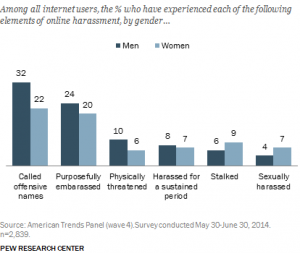This is a letter I sent to New Scientist on 13/12/14.
Complaint regarding article “Fight back against the hate” by Aviva Rutkin (New Scientist Vol.224, No.2999, 13 Dec 2014, P.20-21)
I am immensely distressed that New Scientist chose to print this article. It is not science and it is not honest. What is it doing in New Scientist?
If New Scientist really had to descend into the fetid mess that is gender politics – and it would be best advised not to – then it is incumbent upon it to take an objective approach. This article fails to do so. In fact the article is simply the same gender-biased stuff that one can read in all the mainstream newspapers and news sites. So why bother? Is New Scientist going into competition with Jezebel?
The article presents the phenomenon of online harassment as if it relates exclusively to female victims. Moreover by emphasising sexual threats it deliberately gives the uninformed reader the impression that perpetrators are invariably male. Both these impressions are false. Against this backdrop the recent Pew Research report is cited as stating that 40% of internet users have been harassed online. This unqualified statistic, following the preceding material, invites the unwary reader to believe that it applies to women being harassed or threatened by men.
But this is an appallingly egregious misrepresentation of the Pew Research report. The headline conclusion of that report is that men experience harassment online more frequently than women – see the histogram which heads this article. Specifically, being called offensive names, being purposefully embarrassed, being physically threatened, and being harassed for a sustained period are all experienced more by men. Whilst more women experience sexual harassment and stalking, the difference between the genders even in these categories is not as marked as implied in the article, namely 10% of men and 16% of women.
That the Pew Research report has been used spuriously to support a perspective which is diametrically opposed to its actual findings is outrageously dishonest.
The issue as to who the perpetrators of this online abuse may be is less clear. But if it follows the pattern of juvenile bullying online then same-sex perpetrators will be nearly twice as common as opposing-sex perpetrators (see Table 3 of Ref.[1]). Certainly severe online threats by women against other women do occur. The first person jailed in the UK for online bullying was a woman, Keeley Houghton, and one of the two people imprisoned in the infamous Caroline Criado-Perez affair was a woman. And the distressing popularity of such sentiments as #KillAllMen is testament to there being no shortage of women willing to threaten men online.
But there is more to this issue than an argument as to which gender is subject to more online verbal abuse. It is actually a bid by those of a certain political ideology to control what views may be expressed online. The group cited in the article, WAM (Women, Action and the Media) have already successfully coerced Facebook and Twitter into removing material of which they, WAM, disapproved. They have also had suspended the Twitter accounts of people who expressed opinions contrary to WAM’s politics. These incidents did not involve abuse or threats. But once the principle of Twitter handing over the role of censor to organisations such as WAM is established, the way is open for political censorship. In this respect, online abuse of women is merely a Trojan Horse being cynically exploited as a power play by those with a totalitarian political agenda.
That this is the true motivation underlying the clamour about online harassment is betrayed by the chillingly frank quote in the article from Mary Anne Franks, “They (the likes of Twitter and Facebook) are not required to enforce free speech, but can instead set their own rules for what is permissible on their platform“.
Of course my own gender political complexion will be apparent. I do not expect New Scientist to share it. But that is not the point. The point is that this article is not science. Nor is it objective. Nor is it honest. It is propaganda.
I would urge New Scientist to re-examine its editorial policy on this matter. There is every chance that if it does not do so then the good name of the journal will ultimately become besmirched. It seems a pointless risk to take given that these matters are beyond the journal’s natural remit.
Addendum added 31/12/14: Anita Sarkeesian was one of the women mentioned in this New Scientist article as being the recipient of on-line abuse. There appears to be a credible case that Sarkeesian has fraudulently sent abuse to herself. I have had no response from New Scientist.
References (other than those linked above)
- The JAMA Network: Psychosocial Risk Factors Associated With Cyberbullying Among Adolescents: A Population-Based Study. Arch Gen Psychiatry. 2010;67(7):720-728.

Pingback: That Google Memo | The Illustrated Empathy Gap
Pingback: One Day, 4/3/16 | mra-uk
Thank you! I agree wholeheartedly! There is a disturbing trend among science writers to place ‘social justice’ ideology before science. New Scientist and Scientific American are the worst offenders. In fact, #shirtstorm was created by an attention hungry (and mediocre) science writer at The Atlantic. There needs to be pushback. For instance, there have been numerous credible studies comparing the neuroanatomy of males and females that have found subtle differences . . . but the science writing status quo is in denial and finds specious reasons to ignore the research. Thanks for the letter . . . perhaps there needs to be a #gamergate type movement focusing on the advertisers of these magazines to right the ship in American science writing.